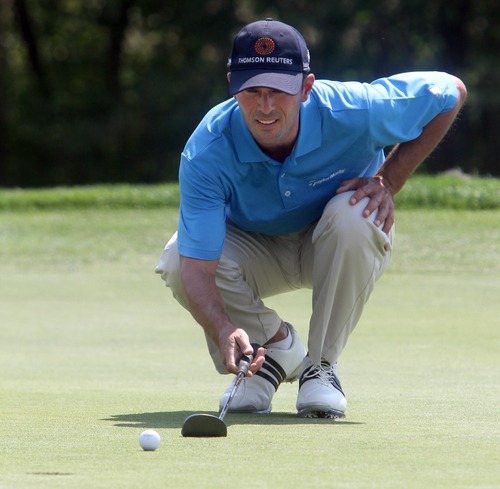This is an archived article that was published on sltrib.com in 2013, and information in the article may be outdated. It is provided only for personal research purposes and may not be reprinted.
In 10 years, the length of the biggest putt of Mike Weir's life has grown considerably.
So has the achievement that followed.
The Sandy resident is observing the 10th anniversary of his Masters victory, an indelible memory for him and anyone who followed his career through his BYU days and beyond. Yet the look back also comes with a sense of disappointment, considering that his first major triumph at Augusta National Golf Club seemed like only the beginning for him, at the time.
What's more, as he rebuilds his game in the wake of recent injuries, Weir is questionable for this week's tournament with rib cartilage problems.
He's trying not to wonder why golf has become such a struggle for him, and focusing on rediscovering the swing and the competitive traits that made him an elite player in 2003. That was true not only during the Masters, because he already had won two tournaments that season. But there was nothing quite like standing over that par putt — alternately described as 6, 7 and 8 feet, as the years have gone by — on the 18th green in his bid to force a playoff with Len Mattiace.
"Well, on a regular day, a Thursday morning on the 18th hole, an 8-footer straight up the hill, you're going to make quite a few of them," Weir said during a recent teleconference. "But a do-or-die putt at a major championship, win or lose, you'd be my guest in guessing how many guys are going to make that putt. I don't think a whole lot."
Weir earned the green jacket on the first playoff hole (No. 10), even with his only bogey of that Sunday, having shot a 4-under-par 68 in regulation. Mattiace almost delivered one of the greatest final rounds in major tournament history, but bogeyed the 18th hole for a 65.
Weir, 42, has won only two tournaments since then. His earnings of more than $27 million hardly speak of a failed career, but he has not continued on the trajectory that his Masters performance and No. 3 world ranking seemingly created. Swing changes and injuries have contributed to his troubles.
He remained a top-30 player on the PGA Tour money list through 2009, but an elbow injury that resulted from hitting a tree root in April 2010 derailed his game. "My wife [Bricia] is always saying things happen for a reason. I'm not sure I agree with her on that. … Maybe this was a way to slow me down and enjoy my family, which I've been able to do a lot in the last few years," said Weir, a father of two teenage daughters. "It's been disappointing career-wise to not play how I [once] played, but I haven't let it affect my life and the way I look at life."
With intermittent success in the first three months of 2013, Weir liked the way he game was coming around until was forced to from the Arnold Palmer Invitational two weeks ago — after making the 36-hole cut — because of his rib injury. He's done nothing but rest since then, hoping to be able to tee it up Thursday at Augusta National.
For Weir, the most positive aspect of observing this 10-year anniversary is thinking back even further, remembering how it took him six years to reach the PGA Tour after concluding his BYU career in 1992 — a point driven home in a recent documentary about the Masters victory that was produced in his native Canada.
"It was never easy for me," he said. "I've always had kind of these struggles in my game. I guess reflecting that way just kind of puts things in perspective and makes more more determined at the point I'm at right now."
Twitter: @tribkurt





